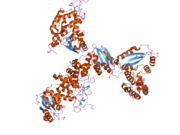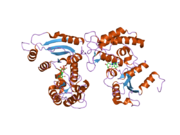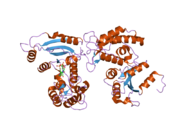CD38
Ensembl | |||||||||
|---|---|---|---|---|---|---|---|---|---|
| UniProt | |||||||||
| RefSeq (mRNA) | |||||||||
| RefSeq (protein) | |||||||||
| Location (UCSC) | Chr 4: 15.78 – 15.85 Mb | Chr 5: 44.03 – 44.07 Mb | |||||||
| PubMed search | [3] | [4] | |||||||
| View/Edit Human | View/Edit Mouse |
CD38 (
In humans, the CD38 protein is encoded by the CD38
History
CD38 was first identified in 1980 as a surface marker (cluster of differentiation) of thymus cell lymphocytes.[10][11] In 1992 it was additionally described as a surface marker on B cells, monocytes, and natural killer cells (NK cells).[10] About the same time, CD38 was discovered to be not simply a marker of cell types, but an activator of B cells and T cells.[10] In 1992 the enzymatic activity of CD38 was discovered, having the capacity to synthesize the calcium-releasing second messengers cyclic ADP-ribose (cADPR) and nicotinic acid adenine dinucleotide phosphate (NAADP).[10]
Tissue distribution
CD38 is most frequently found on plasma B cells, followed by natural killer cells, followed by B cells and T cells, and then followed by a variety of cell types.[12]
Function
CD38 can function either as a receptor or as an enzyme.[13] As a receptor, CD38 can attach to CD31 on the surface of T cells, thereby activating those cells to produce a variety of cytokines.[13] CD38 activation cooperates with TRPM2 channels to initiate physiological responses such as cell volume regulation.[14]
CD38 is a multifunctional
These reaction products are essential for the regulation of intracellular Ca2+.[19] CD38 occurs not only as an ectoenzyme on cell outer surfaces, but also occurs on the inner surface of cell membranes, facing the cytosol performing the same enzymatic functions.[20]
CD38 is believed to control or influence neurotransmitter release in the brain by producing cADPR.[21] CD38 within the brain enables release of the affiliative neuropeptide oxytocin.[22]
Like CD38, CD157 is a member of the ADP-ribosyl cyclase family of enzymes that catalyze the formation of cADPR from NAD+, although CD157 is a much weaker catalyst than CD38.[23] The SARM1 enzyme also catalyzes the formation of cADPR from NAD+,[20] but SARM1 elevates cADPR much more efficiently than CD38.[24]
Clinical significance
The loss of CD38 function is associated with impaired immune responses, metabolic disturbances, and behavioral modifications including social amnesia possibly related to autism.[19][25]
The cytokine
The CD38 protein is a marker of cell activation. It has been connected to
CD38 increases airway contractility hyperresponsiveness, is increased in the lungs of asthmatic patients, and amplifies the inflammatory response of airway smooth muscle of those patients.[16]
Clinical application
CD38 inhibitors may be used as therapeutics for the treatment of asthma.[30]
CD38 has been used as a prognostic marker in leukemia.[31]
Daratumumab (Darzalex) which targets CD38 has been used in treating multiple myeloma.[32][33]
The use of Daratumumab can interfere with pre-
Inhibitors
- Cassic acid (Rhein) [35]
- CD38-IN-78c[36]
- Chrysanthemin (Kuromanin) [37]
- compound 1ai [38]
- compound 1am [39][40]
- Daratumumab[41]
- Isatuximab[42]
- Felzartamab (MOR202)[43]
- apigenin[44]
- Luteolinidin[45]
- MK-0159[46][47]
- TNB-738[48]
Aging studies
A gradual increase in CD38 has been implicated in the decline of
Decline of NAD+ in the brain with age may be due to increased CD38 on
References
- ^ a b c GRCh38: Ensembl release 89: ENSG00000004468 – Ensembl, May 2017
- ^ a b c GRCm38: Ensembl release 89: ENSMUSG00000029084 – Ensembl, May 2017
- ^ "Human PubMed Reference:". National Center for Biotechnology Information, U.S. National Library of Medicine.
- ^ "Mouse PubMed Reference:". National Center for Biotechnology Information, U.S. National Library of Medicine.
- S2CID 44430455.
- ^ "Entrez Gene: CD38 CD38 molecule".
- S2CID 29082806.
- PMID 9074508.
- ^ S2CID 205732787.
- ^ ISBN 978-1-4613-4996-9.
- PMID 6966400.
- PMID 29118010.
- ^ S2CID 96435958.
- PMID 22219339.
- ^ PMID 32709019.
- ^ PMID 32480246.
- PMID 29634344.
- PMID 11829748.
- ^ PMID 18626062.
- ^ PMID 31672920.
- ^ PMID 32085567.
- S2CID 216638884.
- PMID 31881755.
- PMID 31128467.
- S2CID 33172185.
- PMID 32245149.
- ^ PMID 31963337.
- PMID 29576747.
- PMID 30622116.
- PMID 27939939.
- PMID 11137554.
- S2CID 11977989.
- PMID 27910963.
- S2CID 29156699.
- S2CID 41844152.
- PMID 29719225.
- PMID 21641214.
- PMID 26267483.
- PMID 29576271.
- S2CID 54158219.
- PMID 30033840.
- ^ "Sarclisa EPAR". European Medicines Agency (EMA). 29 July 2021. Retrieved 29 July 2021.
- S2CID 212718499.
- PMID 23172919.
- PMID 28108596.
- S2CID 250090300.
- PMID 35704572.
- PMID 35867844.
- PMID 27304511.
- PMID 27304496.
- PMID 29719225.
- ^ PMID 32595066.
- S2CID 220254270.
- ^ PMID 32774895.
- PMID 28721272.
- PMID 33199924.
Further reading
- States DJ, Walseth TF, Lee HC (December 1992). "Similarities in amino acid sequences of Aplysia ADP-ribosyl cyclase and human lymphocyte antigen CD38". Trends in Biochemical Sciences. 17 (12): 495. PMID 1471258.
- Malavasi F, Funaro A, Roggero S, Horenstein A, Calosso L, Mehta K (March 1994). "Human CD38: a glycoprotein in search of a function". Immunology Today. 15 (3): 95–7. PMID 8172650.
- Guse AH (May 1999). "Cyclic ADP-ribose: a novel Ca2+-mobilising second messenger". Cellular Signalling. 11 (5): 309–16. PMID 10376802.
- Funaro A, Malavasi F (1999). "Human CD38, a surface receptor, an enzyme, an adhesion molecule and not a simple marker". Journal of Biological Regulators and Homeostatic Agents. 13 (1): 54–61. PMID 10432444.
- Mallone R, Perin PC (2006). "Anti-CD38 autoantibodies in type? diabetes". Diabetes/Metabolism Research and Reviews. 22 (4): 284–94. PMID 16544364.
- Partidá-Sánchez S, Rivero-Nava L, Shi G, Lund FE (2007). "CD38: an ecto-enzyme at the crossroads of innate and adaptive immune responses". Crossroads between Innate and Adaptive Immunity. Advances in Experimental Medicine and Biology. Vol. 590. pp. 171–83. PMID 17191385.
- Jackson DG, Bell JI (April 1990). "Isolation of a cDNA encoding the human CD38 (T10) molecule, a cell surface glycoprotein with an unusual discontinuous pattern of expression during lymphocyte differentiation". Journal of Immunology. 144 (7): 2811–5. S2CID 29082806.
- Dianzani U, Bragardo M, Buonfiglio D, Redoglia V, Funaro A, Portoles P, et al. (May 1995). "Modulation of CD4 lateral interaction with lymphocyte surface molecules induced by HIV-1 gp120". European Journal of Immunology. 25 (5): 1306–11. S2CID 37717142.
- Nakagawara K, Mori M, Takasawa S, Nata K, Takamura T, Berlova A, et al. (1995). "Assignment of CD38, the gene encoding human leukocyte antigen CD38 (ADP-ribosyl cyclase/cyclic ADP-ribose hydrolase), to chromosome 4p15". Cytogenetics and Cell Genetics. 69 (1–2): 38–9. PMID 7835083.
- Tohgo A, Takasawa S, Noguchi N, Koguma T, Nata K, Sugimoto T, et al. (November 1994). "Essential cysteine residues for cyclic ADP-ribose synthesis and hydrolysis by CD38". The Journal of Biological Chemistry. 269 (46): 28555–7. PMID 7961800.
- Takasawa S, Tohgo A, Noguchi N, Koguma T, Nata K, Sugimoto T, et al. (December 1993). "Synthesis and hydrolysis of cyclic ADP-ribose by human leukocyte antigen CD38 and inhibition of the hydrolysis by ATP". The Journal of Biological Chemistry. 268 (35): 26052–4. PMID 8253715.
- Nata K, Takamura T, Karasawa T, Kumagai T, Hashioka W, Tohgo A, et al. (February 1997). "Human gene encoding CD38 (ADP-ribosyl cyclase/cyclic ADP-ribose hydrolase): organization, nucleotide sequence and alternative splicing". Gene. 186 (2): 285–92. PMID 9074508.
- Feito MJ, Bragardo M, Buonfiglio D, Bonissoni S, Bottarel F, Malavasi F, et al. (August 1997). "gp 120s derived from four syncytium-inducing HIV-1 strains induce different patterns of CD4 association with lymphocyte surface molecules". International Immunology. 9 (8): 1141–7. PMID 9263011.
- Ferrero E, Malavasi F (October 1997). "Human CD38, a leukocyte receptor and ectoenzyme, is a member of a novel eukaryotic gene family of nicotinamide adenine dinucleotide+-converting enzymes: extensive structural homology with the genes for murine bone marrow stromal cell antigen 1 and aplysian ADP-ribosyl cyclase". Journal of Immunology. 159 (8): 3858–65. S2CID 25461949.
- Deaglio S, Morra M, Mallone R, Ausiello CM, Prager E, Garbarino G, et al. (January 1998). "Human CD38 (ADP-ribosyl cyclase) is a counter-receptor of CD31, an Ig superfamily member". Journal of Immunology. 160 (1): 395–402. S2CID 15132619.
- Yagui K, Shimada F, Mimura M, Hashimoto N, Suzuki Y, Tokuyama Y, et al. (September 1998). "A missense mutation in the CD38 gene, a novel factor for insulin secretion: association with Type II diabetes mellitus in Japanese subjects and evidence of abnormal function when expressed in vitro". Diabetologia. 41 (9): 1024–8. PMID 9754820.
External links
- CD38+Antigens at the U.S. National Library of Medicine Medical Subject Headings (MeSH)
- Human CD38 genome location and CD38 gene details page in the UCSC Genome Browser.
- GeneCard CD38 [1]
- Overview of all the structural information available in the PDB for UniProt: P28907 (ADP-ribosyl cyclase/cyclic ADP-ribose hydrolase 1) at the PDBe-KB.
- CD38














